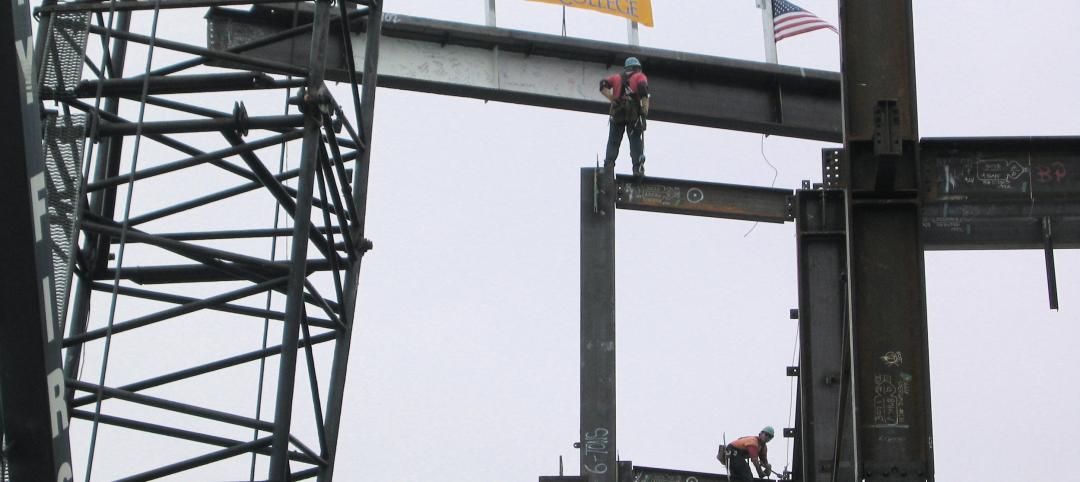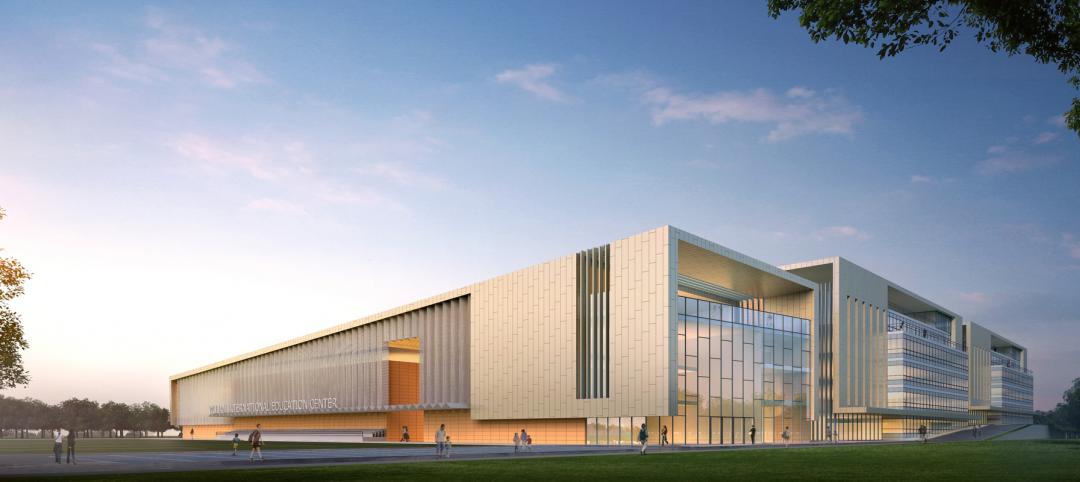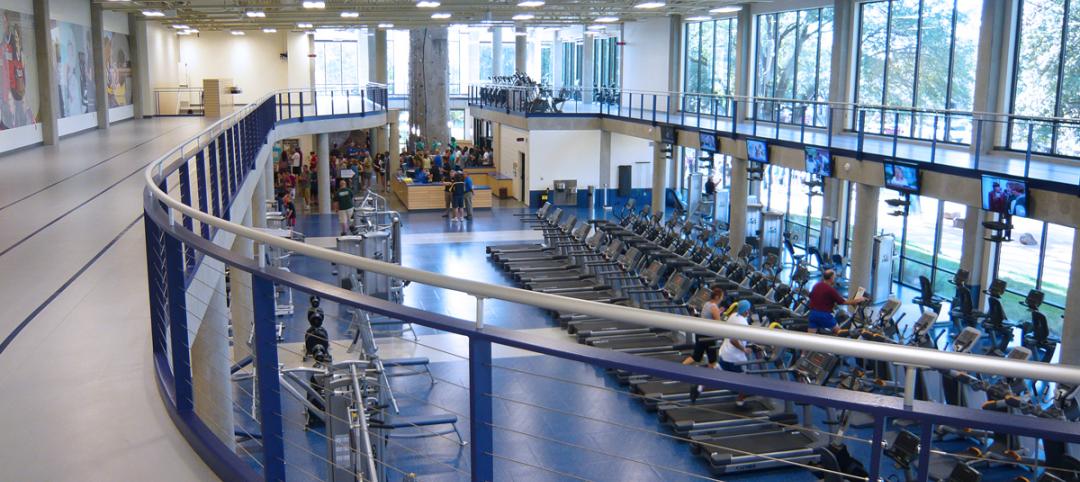
The city of Phoenix has sprawling suburbs, but its outward expansion caused the downtown core to stagnate—a problem not uncommon to other major metropolitan areas. Reviving the city became a hotbed issue for Mayor Phil Gordon, who envisioned a vibrant downtown that offered opportunities for living, working, learning, and playing.
The Mayor's plans for downtown redevelopment involved public-private partnerships, which led him to Arizona State University President Michael Crow. Crow was interested in expanding ASU's presence within the metro Phoenix area (ASU's main campus is in Tempe), so the city and school jointly developed a master plan for a new campus on nine city blocks. In 2006, voters approved $223 million in bonds, with $71 million slated for construction of the Walter Cronkite School of Journalism and Mass Communication, the new campus's first facility.
 |
| The two-story First Amendment Forum serves as the school’s “living room,” with a mezzanine level offering extra seating. Large windows between the forum and adjoining spaces, such as conference rooms and the Library & Student Resource Center, create a feeling that activities are always “on air.” |
The RFP for a design-build team was won by the alliance of HDR Architecture (executive architect), Ehrlich Architects (design architect), and Sundt Construction (GC) and required the team to adhere to an absolute fixed budget and a maximum 20-month timeline from award to occupancy certificate.
The Building Team utilized integrated project delivery and BIM to stay on time and on budget. Among other things, IPD and BIM enabled the Building Team to create detailed cost models instead of cost estimates, so that by the close of business every Friday the project budget was rectified.
IPD also helped with the fast-track schedule by allowing the project to be broken up into multiple packages, each with its own senior IPD leader and production team. The strategy allowed foundations to be poured before the superstructure design was complete and before the exterior skin was finalized. A special team was assigned to acquiring entitlements and building permits to accommodate the project's breakneck pace, and the city helped expedite the review process.
 |
| Studio spaces were built out quickly, but during interior improvements the floors received a top coating to create a camera-friendly flatness. |
The building's basic rectilinear form—a simple 30-foot-square exposed structural concrete column grid, burnished concrete block walls, and insulated cladding—was a practical choice for the project's budget and timeline. It enabled the Building Team to maximize square footage: ASU had a lengthy list of features they needed to squeeze into the six-story, 223,000-sf facility. The Walter Cronkite School of Journalism and Mass Communication is sandwiched between the building's ground floor, which houses the main lobby and retail and restaurant space, and the top floor, which is utilized by the city's PBS station, KAET/Channel 8. The university space includes 12 classrooms, seven working newsrooms, two state-of-the-art television studios, a library, a 150-seat theater-style auditorium, and a 1,500-sf exhibition gallery.
The centerpiece is a large “living room,” dubbed the First Amendment Forum. This two-story space—with mezzanine—is used as a gathering area for students during the day, while in the evening it becomes a public forum for students and industry leaders to engage in discussion and debate. Five hi-def flat-screen televisions and a large hi-def rear projector broadcast the day's news and other events. Walter Cronkite's famous sign-off, “And that's the way it is,” is inscribed on one wall.
To moderate the monolithic effect of the rectangular building, the Building Team sliced off a bit here and there and bumped out stairwells several feet from exterior walls. A combination of thin vertical and long horizontal windows, a wraparound exterior balcony, and multicolored corrugated metal cladding in a pattern inspired by FCC's radio spectrum chart further break up what could be a blocky exterior.
The facility opened in May 2008, and is adjacent to a pedestrian boulevard and across the street from a newly completed high-rise residence hall and a student union created by the adaptive reuse of a historic post office building. The city's new light rail system stops near the main entrance. The downtown now bustles with student life.
The project impressed Building Team Awards judge Dan Huntington. “Twenty months from start to certificate of occupancy on a building this size—that's pretty impressive,” says Huntington, SE, PE, LEED AP, associate principal at KJWW Engineering Consultants in Rock Island, Ill. “They had a very large task put in front of them, and they were very successful.”
Related Stories
| Mar 27, 2012
Groundbreaking held for Valencia College West Campus Building 10 in Orlando
Project led by design-build team of SchenkelShultz Architecture and McCree General Contractors, both of Orlando.
| Mar 26, 2012
McCarthy tops off Math and Science Building at San Diego Mesa College
Designed by Architects | Delawie Wilkes Rodrigues Barker, the new San Diego Mesa College Math and Science Building will provide new educational space for students pursuing degree and certificate programs in biology, chemistry, physical sciences and mathematics.
| Mar 26, 2012
Ball State University completes nation's largest ground-source geothermal system
Ball State's geothermal system will replace four aging coal-fired boilers to provide renewable power that will heat and cool 47 university buildings, representing 5.5-million-sf on the 660-acre campus.
| Mar 14, 2012
Tsoi/Kobus and Centerbrook to design Jackson Laboratory facility in Farmington, Conn.
Building will house research into personalized, gene-based cancer screening and treatment.
| Mar 6, 2012
EwingCole completes first design-build project for the USMA
The second phase of the project, which includes the academic buildings and the lacrosse and football fields, was completed in January 2012.
| Mar 6, 2012
Joliet Junior College achieves LEED Gold
With construction managed by Gilbane Building Company, Joliet Junior College’s Facility Services Building combines high-performance technologies with sustainable materials to meet aggressive energy efficiency goals.
| Mar 1, 2012
Cornell shortlists six architectural firms for first building on tech campus
Each of the firms will be asked to assemble a team of consultants and prepare for an interview to discuss their team’s capabilities to successfully design the university’s project.
| Feb 28, 2012
Salem State University Library & Learning Commons topped off
When it opens to students in the fall of 2013, the $60 million facility will offer new archival space; circulation and reference areas; collections; reading spaces; study rooms; instruction labs and a Dean’s suite.
| Feb 22, 2012
Perkins Eastman expands portfolio in China and Vietnam
Recent awards, project progress signal ongoing commitment to region.
| Feb 14, 2012
Angelo State University opens doors to new recreation center expansion
Designed by SmithGroup, the JJR_Center for Human Performance offers enhanced fitness options, dynamic gathering space.
















